-
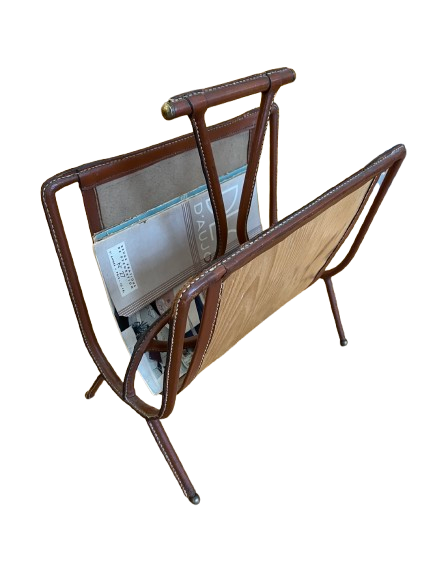
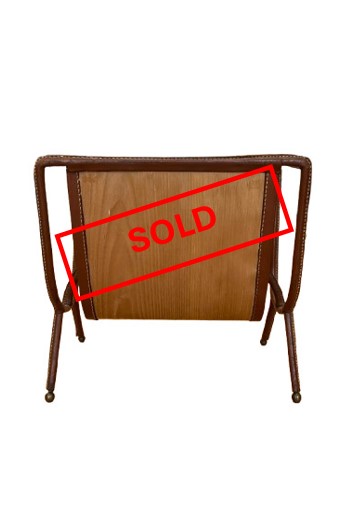 Jacques Adnet (1900-1984) était un architecte et designer français qui a débuté sa carrière dans l'un des premiers ateliers d'art moderne, La Maîtrise, dirigé par Maurice Dufrêne. En 1928, Jacques Adnet devient le directeur de la Compagnie des Arts Français et collabore avec de nombreux artistes tels que Picasso, Dunand et Perriand. Grâce à ses œuvres présentant des motifs épurés et simples et l'utilisation de nouveaux matériaux comme le verre et le métal, il est considéré comme l'un des principaux représentants du modernisme et de l'Art Déco français. Porte-revues à structure métallique gainée de cuir gold sellier, sabots formés de sphères en laiton, prises animées de cabochons en laiton, feuilles de cuir gold souples doublées d’un placage frêne verni. Dimensions : H : 47 cm ; L : 42,5 cm ; P : 23,5 cm. ___________________________________ Jacques Adnet (1900-1984) was a French architect and designer who began his career in one of the earliest modern art workshops, La Maîtrise, directed by Maurice Dufrêne. In 1928, Jacques Adnet became the head of the Compagnie des Arts Français and collaborated with numerous artists such as Picasso, Dunand, and Perriand. Thanks to his works featuring clean, simple motifs and the use of new materials like glass and metal, he is considered one of the main representatives of French modernism and Art Deco. Magazine rack with a metal structure covered in gold leather, brass sphere-shaped feet, brass cabochon handles, and flexible gold leather leaves lined with varnished ash veneer. Dimensions: H: 47 cm; W: 42.5 cm; D: 23.5 cm.
Jacques Adnet (1900-1984) était un architecte et designer français qui a débuté sa carrière dans l'un des premiers ateliers d'art moderne, La Maîtrise, dirigé par Maurice Dufrêne. En 1928, Jacques Adnet devient le directeur de la Compagnie des Arts Français et collabore avec de nombreux artistes tels que Picasso, Dunand et Perriand. Grâce à ses œuvres présentant des motifs épurés et simples et l'utilisation de nouveaux matériaux comme le verre et le métal, il est considéré comme l'un des principaux représentants du modernisme et de l'Art Déco français. Porte-revues à structure métallique gainée de cuir gold sellier, sabots formés de sphères en laiton, prises animées de cabochons en laiton, feuilles de cuir gold souples doublées d’un placage frêne verni. Dimensions : H : 47 cm ; L : 42,5 cm ; P : 23,5 cm. ___________________________________ Jacques Adnet (1900-1984) was a French architect and designer who began his career in one of the earliest modern art workshops, La Maîtrise, directed by Maurice Dufrêne. In 1928, Jacques Adnet became the head of the Compagnie des Arts Français and collaborated with numerous artists such as Picasso, Dunand, and Perriand. Thanks to his works featuring clean, simple motifs and the use of new materials like glass and metal, he is considered one of the main representatives of French modernism and Art Deco. Magazine rack with a metal structure covered in gold leather, brass sphere-shaped feet, brass cabochon handles, and flexible gold leather leaves lined with varnished ash veneer. Dimensions: H: 47 cm; W: 42.5 cm; D: 23.5 cm. -
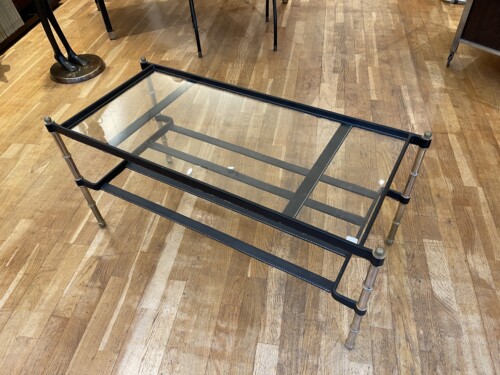
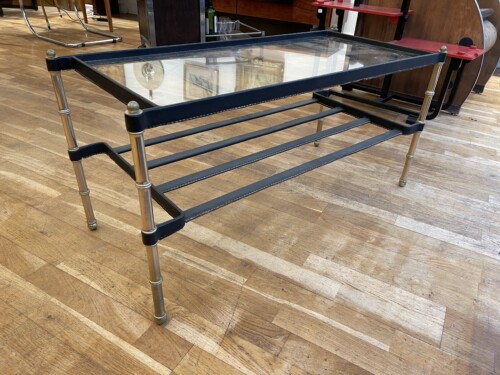 Vers 1950 Table basse du célèbre designer français Jacques Adnet (1900-1984). Il s'agit d'une création typique d'Adnet du début des années 1950 utilisant la technique du "Piqué Sellier" (technique du "cuir cousu") qu'il a inventée et adaptée aux meubles, les recouvrant de cuir. La table a une structure en laiton doré avec des pieds imitant le bambou et partiellement recouverts de cuir piqué. Plateau en verre (probablement remplacé). Très bon état. H : 47 cm ; L : 95 cm ; P : 42 cm Pour plus d’informations sur le créateur, cliquer sur le nom : Jacques ADNET
Vers 1950 Table basse du célèbre designer français Jacques Adnet (1900-1984). Il s'agit d'une création typique d'Adnet du début des années 1950 utilisant la technique du "Piqué Sellier" (technique du "cuir cousu") qu'il a inventée et adaptée aux meubles, les recouvrant de cuir. La table a une structure en laiton doré avec des pieds imitant le bambou et partiellement recouverts de cuir piqué. Plateau en verre (probablement remplacé). Très bon état. H : 47 cm ; L : 95 cm ; P : 42 cm Pour plus d’informations sur le créateur, cliquer sur le nom : Jacques ADNET
Coffee table Circa 1950 Coffee table by famous French designer Jacques Adnet (1900-1984). It is a typical creation of Adnet from the early 1950's using 'Piqué Sellier" technique ("stitched leather" technique) he invented and adapted to furniture, covering them with leather. The table has a gilded brass structure with legs imitating bamboo and partially covered with stitched leather. Glass top (probably replaced). Very good condition. H : 47 cm ; W : 95 cm ; D : 42 cm For more informations : Jacques ADNET -
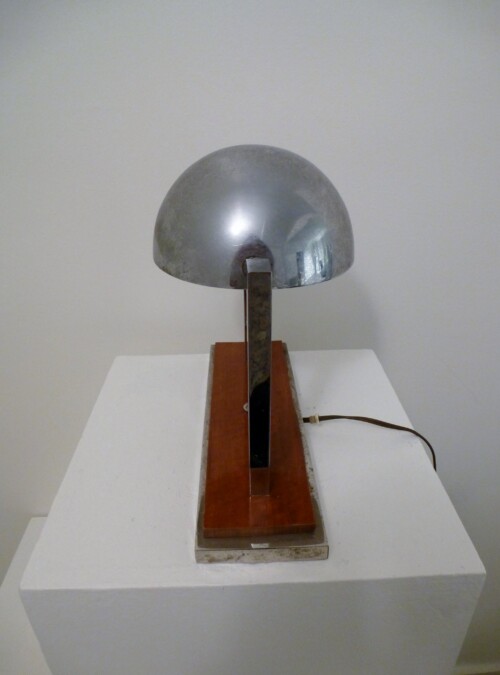
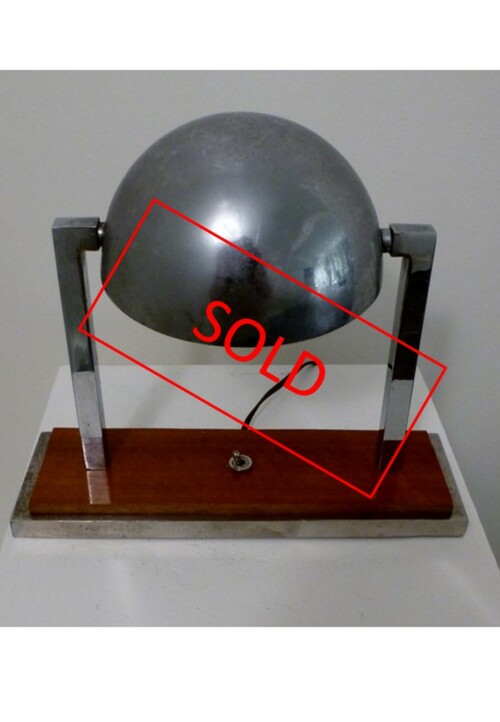 Jacques ADNET (1900-1984) Lampe "Diane" moderniste à structure en métal chromé sur base en hêtre teinté enserrant un réflecteur hémisphérique orientable. Vers 1930 H : 26 cm ; L : 30 cm ; P : 16 cm Pour plus d'informations sur le créateur, cliquer sur le nom : Jacques ADNET
Jacques ADNET (1900-1984) Lampe "Diane" moderniste à structure en métal chromé sur base en hêtre teinté enserrant un réflecteur hémisphérique orientable. Vers 1930 H : 26 cm ; L : 30 cm ; P : 16 cm Pour plus d'informations sur le créateur, cliquer sur le nom : Jacques ADNET
Desk table lamp "Diane" by Jacques Adnet, circa 1930."Diane" modernist table lamp with a chrome steel structure standing on a tainted beech wood base holding a light hemispherical orientable reflector. Reflector's diameter: 16cm.
Around 1930. Original chrome. Renewed wiring for European use.
The original base switcher has been bypassed and replaced by a switcher on the electrical wire.
Dimensions :H : 10.24 in. ; W : 11.81 in. ; D : 6.3 in.H : 26 cm ; W : 30 cm ; D : 16 cmFor more information : Jacques ADNET -
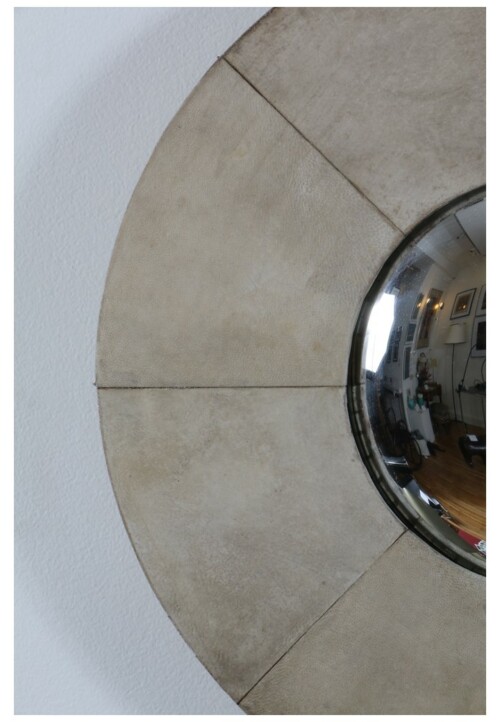
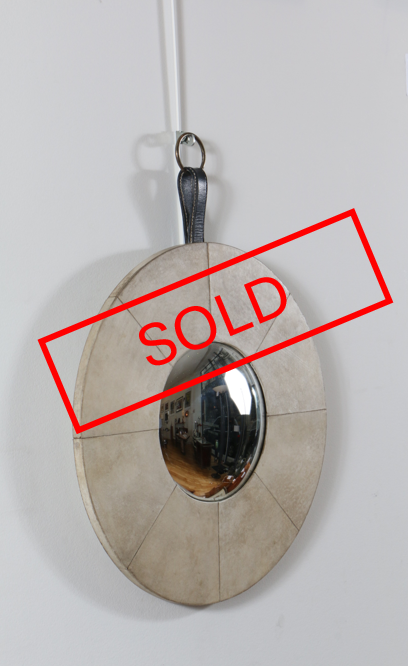 Jacques ADNET (1900 - 1984) Miroir sorcière gainé de parchemin blanc à accroche en cuir noir piqué cellier composé d'un anneau en laiton doré Vers 1940-1950 Hauteur : 57 cm ; Diamètre : 45 cm Pour plus d'informations sur le créateur, cliquer sur le nom : Jacques ADNET
Jacques ADNET (1900 - 1984) Miroir sorcière gainé de parchemin blanc à accroche en cuir noir piqué cellier composé d'un anneau en laiton doré Vers 1940-1950 Hauteur : 57 cm ; Diamètre : 45 cm Pour plus d'informations sur le créateur, cliquer sur le nom : Jacques ADNET
Eccentric Mirror Covered with Parchment by Jacque Adnet, 1940-1950.
Eccentric Mirror (also known as Convex Mirror or Witch Mirror - "Miroir de Sorcière") by Jacques Adnet (1900-1984).
Wood covered with white parchment, Convex mirror, Stitched leather and brass ring.
Very good condition. Period: 1940/1950.
H : 22.44 in. (57 cm) ; Diameter : 17.71 in. (45 cm) For more information : Jacques ADNET -
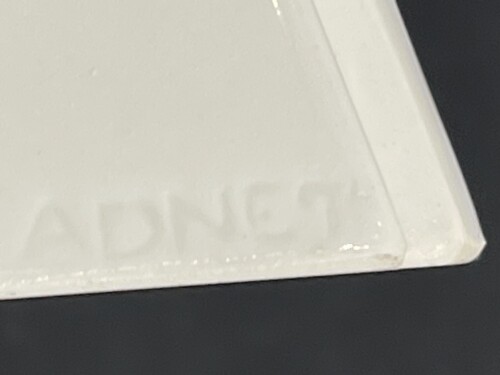
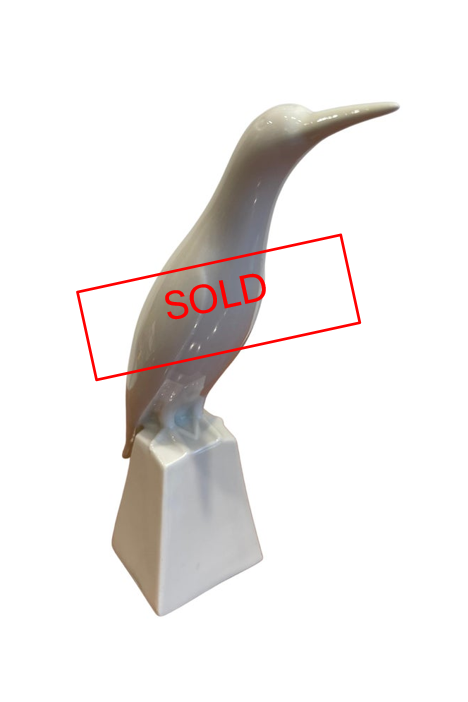 Très rare sculpture en porcelaine représentant un oiseau stylisé par Jacques Adnet (1900-1984) et fabriquée par Gérard, entreprise de porcelaine Dufraissex et Abbot basée à Limoges pour la Compagnie des Arts Français. Porcelaine émaillée ivoire, vers 1930. Signée ADNET sur la base, porte la marque du fabricant à l'intérieur de la base. Hauteur : 20 cm. Condition parfaite. Bibliographie : Les Echos des Industries d'Art - N° 40 de novembre 1928 : modèle identique reproduit page 14. Pour plus d'informations sur Jacques Adnet, cliquez ici. Very rare porcelain sculpture representing a stylized bird by Jacques Adnet (1900-1984) and manufactured by Gérard, Dufraissex et Abbot porcelain company based in Limoges for Compagnie des Arts Français. Porcelain with ivory enamel, circa 1930. Signed ADNET on the base, wears the mark of the manufacturer inside the base. Height: 20cm. Perfect condition. Bibliography : Les Echos des Industries d'Art - N° 40 dated November 1928 : identical model reproduced page 14. For more information about Jacques Adnet, click here.
Très rare sculpture en porcelaine représentant un oiseau stylisé par Jacques Adnet (1900-1984) et fabriquée par Gérard, entreprise de porcelaine Dufraissex et Abbot basée à Limoges pour la Compagnie des Arts Français. Porcelaine émaillée ivoire, vers 1930. Signée ADNET sur la base, porte la marque du fabricant à l'intérieur de la base. Hauteur : 20 cm. Condition parfaite. Bibliographie : Les Echos des Industries d'Art - N° 40 de novembre 1928 : modèle identique reproduit page 14. Pour plus d'informations sur Jacques Adnet, cliquez ici. Very rare porcelain sculpture representing a stylized bird by Jacques Adnet (1900-1984) and manufactured by Gérard, Dufraissex et Abbot porcelain company based in Limoges for Compagnie des Arts Français. Porcelain with ivory enamel, circa 1930. Signed ADNET on the base, wears the mark of the manufacturer inside the base. Height: 20cm. Perfect condition. Bibliography : Les Echos des Industries d'Art - N° 40 dated November 1928 : identical model reproduced page 14. For more information about Jacques Adnet, click here. -
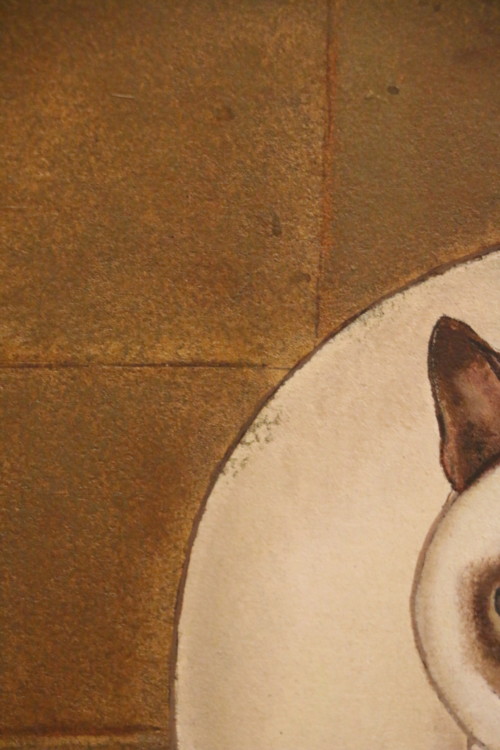
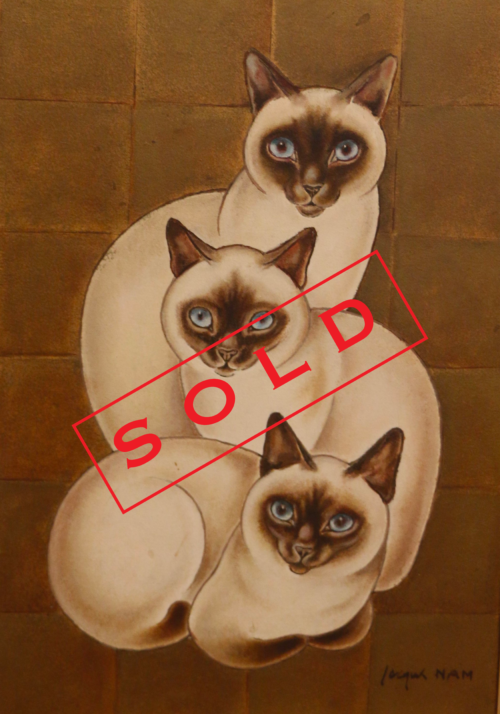 Jacques Nam (1881-1974) Trois chats siamois Huiles sur panneau Signée Année 30 Dimensions : H : 61.5 cm ; L : 48.5 cm Pour plus d’informations sur le créateur, cliquer sur son nom : Jacques Nam
Jacques Nam (1881-1974) Trois chats siamois Huiles sur panneau Signée Année 30 Dimensions : H : 61.5 cm ; L : 48.5 cm Pour plus d’informations sur le créateur, cliquer sur son nom : Jacques Nam
Three siamese cats by Jacques Nam (1881-1974) Oil on paned Signed 1930s Dimensions : H : 24.22 in ; W : 19.1 in H : 61.5 cm ; W : 48.5 cm For more informations : Jacques Nam -
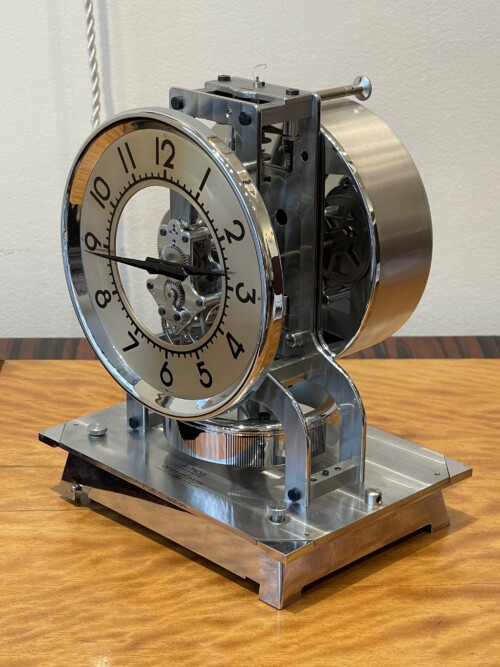
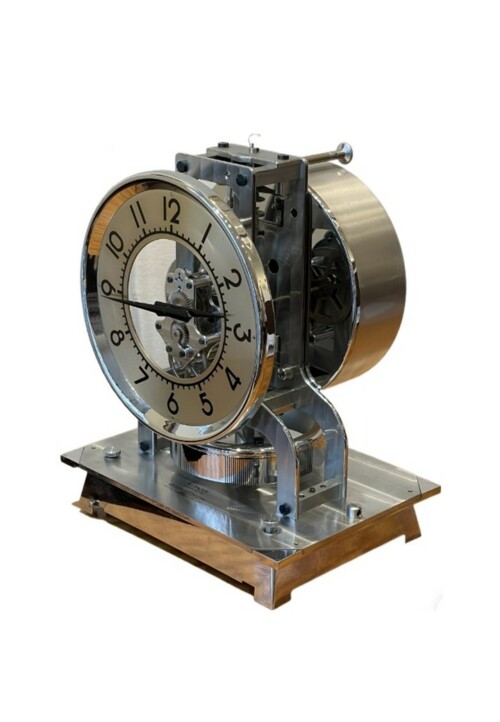
- Vers 1940.
- Faite en métal chromé. La pendule repose sur un socle en métal chromé, et dispose également d’un boîtier vitré en bois. Le cadran est évidé au centre avec un mécanisme apparent, le cercle est argenté avec des chiffres arabes dits “Art Déco”.
- A été révisée par un horloger professionnel et elle est dans un bon état.
- Porte la mention “Fabriqué en Suisse”.
- Signé sur la base “Jaeger-Le Coultre” et “Atmos Brevets Reutter”.
- Circa 1940.
- Made of chromed metal, the clock rests on a chromed metal base and features a glazed wooden case. The dial is open in the center, revealing the mechanism, with a silvered ring and Art Deco-style Arabic numerals.
- It has been serviced by a professional watchmaker and is in good condition.
- It bears the label “Made in Switzerland” and is signed on the base “Jaeger-LeCoultre” and “Atmos Brevets Reutter.”
-
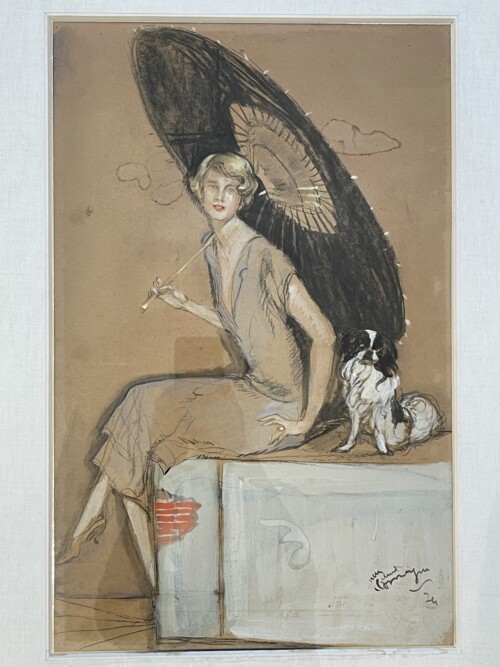
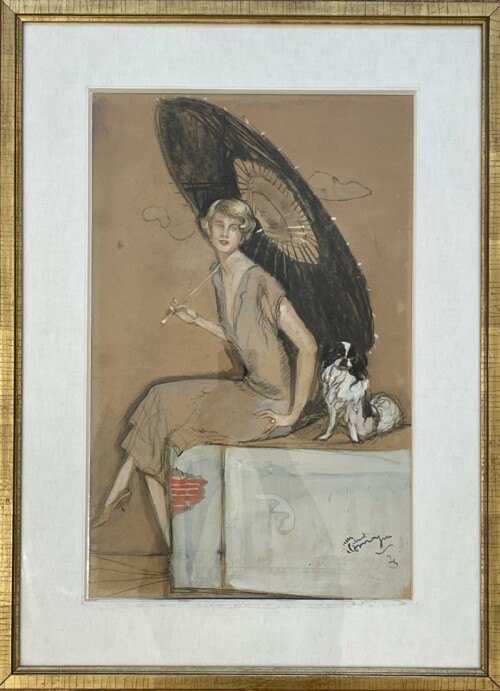 Jean-Gabriel Domergue, fut un peintre et graveur français renommé, particulièrement pour ses portraits de femmes élégantes ou plutôt pour un personnage féminin dans un style qui s’est affirmé au fil du temps, clairement reconnaissable et marqué par l'Art Déco. Petit-cousin de Toulouse-Lautrec, il a étudié aux Beaux-Arts de Paris et a exposé dès 1906 au Salon des artistes français, où il a remporté plusieurs distinctions, dont un deuxième grand prix de Rome en 1913. En 1939, il a réalisé l'affiche iconique du premier Festival de Cannes, finalement annulé, montrant une femme applaudissant aux côtés d’un homme en habit. En 1950, il a été élu à l’Institut de France et est devenu conservateur du musée Jacquemart-André, où il organisait des grandes expositions.
Jean-Gabriel Domergue, fut un peintre et graveur français renommé, particulièrement pour ses portraits de femmes élégantes ou plutôt pour un personnage féminin dans un style qui s’est affirmé au fil du temps, clairement reconnaissable et marqué par l'Art Déco. Petit-cousin de Toulouse-Lautrec, il a étudié aux Beaux-Arts de Paris et a exposé dès 1906 au Salon des artistes français, où il a remporté plusieurs distinctions, dont un deuxième grand prix de Rome en 1913. En 1939, il a réalisé l'affiche iconique du premier Festival de Cannes, finalement annulé, montrant une femme applaudissant aux côtés d’un homme en habit. En 1950, il a été élu à l’Institut de France et est devenu conservateur du musée Jacquemart-André, où il organisait des grandes expositions.- Technique mixte (crayon, fusain, aquarelle et gouache).
- Signé en bas à droite et daté 1924.
- Papier légèrement insolé, petits pliures sur les bordures, quelques taches.
- Encadré sous verre.
Jean-Gabriel Domergue (1889–1962) was a renowned French painter and engraver, celebrated especially for his portraits of elegant women or, more precisely, a feminine figure in a style that evolved over time, clearly recognizable, marked by Art Deco. A distant cousin of Toulouse-Lautrec, he studied at the École des Beaux-Arts in Paris and began exhibiting at the Salon des Artistes Français as early as 1906, where he earned several distinctions, including a second Grand Prix de Rome in 1913. In 1939, he created the iconic poster for the inaugural Cannes Film Festival, which was ultimately canceled, depicting a woman applauding beside a man in formal attire. In 1950, he was elected to the Institut de France and became the curator of the Jacquemart-André Museum, where he organized major exhibitions.- Mixed media (pencil, charcoal, watercolor, and gouache).
- Signed lower right and dated 1924.
- Paper slightly faded, small creases along edges, some spots.
- Framed under glass.
- H: 49.5 cm W: 31.5 cm/ H: 19.5 in W: 12.4 in (at sight)
-
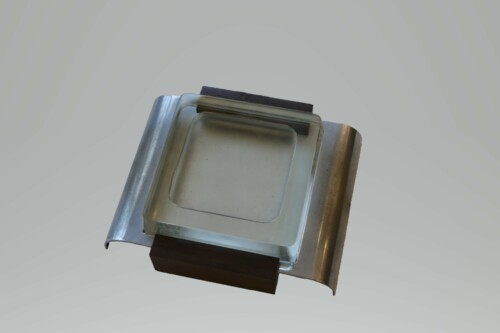
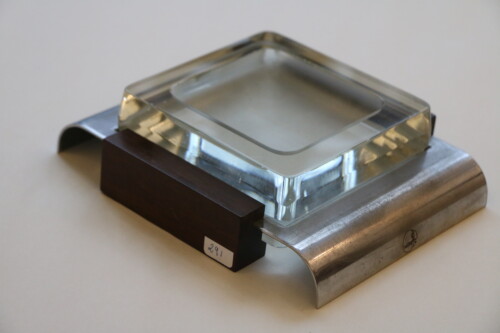 Jean Boris Lacroix (1902-1984) était un designer et architecte français célèbre pour ses créations de luminaires modernistes. Après un apprentissage chez l'ébéniste Paul Dumas, il a fait ses débuts au Salon des Artistes Décorateurs en 1927. Lacroix est devenu une figure clé de l'innovation dans l'éclairage, collaborant avec Robert Caillat, puis Jacques Biny chez Luminalite, où il a exploré des conceptions radicales avec des matériaux comme le métal et le plexiglas. Son travail mêlait des éléments conservateurs des années 1940 avec une modernité audacieuse, produisant des pièces iconiques.
Jean Boris Lacroix (1902-1984) était un designer et architecte français célèbre pour ses créations de luminaires modernistes. Après un apprentissage chez l'ébéniste Paul Dumas, il a fait ses débuts au Salon des Artistes Décorateurs en 1927. Lacroix est devenu une figure clé de l'innovation dans l'éclairage, collaborant avec Robert Caillat, puis Jacques Biny chez Luminalite, où il a exploré des conceptions radicales avec des matériaux comme le métal et le plexiglas. Son travail mêlait des éléments conservateurs des années 1940 avec une modernité audacieuse, produisant des pièces iconiques.- Vide poche moderniste.
- En métal nickelé, verre et palissandre.
- Signé par la marque.
Jean Boris Lacroix (1902-1984) was a French designer and architect known for his modernist lighting designs. After apprenticing with Paul Dumas, he debuted at the Salon des Artistes Décorateurs in 1927. Lacroix became a key figure in lighting innovation, working with Robert Caillat and later Jacques Biny at Luminalite, where he explored radical designs using materials like metal and plexiglass. His work combined conservative 1940s elements with modern materials, producing iconic pieces.- Modernist catchall.
- Nickel-plated metal, glass and rosewood.
- Signed by the brand.
-
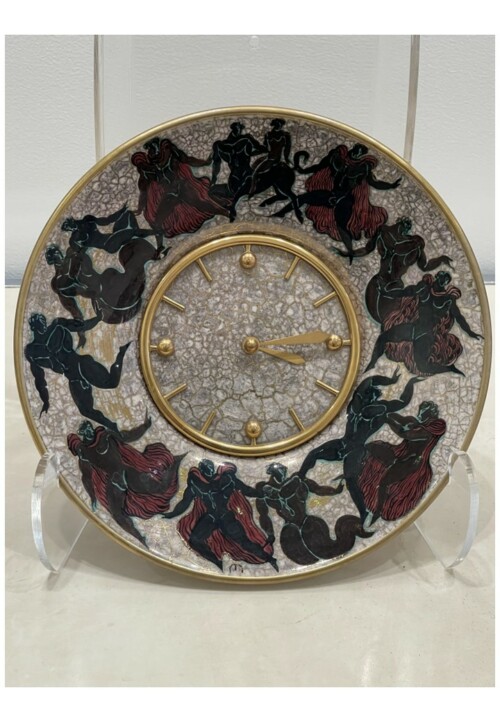
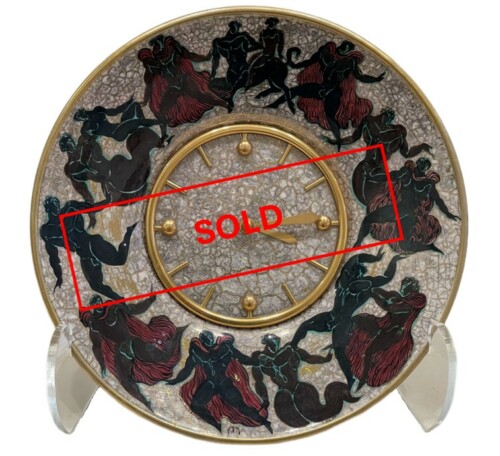 Objet composé d'une pendule signée Hour Lavigne, montée sur un plat en céramique réalisé par Jean Léon Mayodon. Conçue pour être fixée au mur, elle peut aussi servir de pendule de table. Mayodon a également créé un modèle similaire pour Cartier dans les années 1950. Hour Lavigne est connu pour ses mouvements mécaniques haut de gamme, et Mayodon pour ses céramiques néoclassiques.
Objet composé d'une pendule signée Hour Lavigne, montée sur un plat en céramique réalisé par Jean Léon Mayodon. Conçue pour être fixée au mur, elle peut aussi servir de pendule de table. Mayodon a également créé un modèle similaire pour Cartier dans les années 1950. Hour Lavigne est connu pour ses mouvements mécaniques haut de gamme, et Mayodon pour ses céramiques néoclassiques.- Le mouvement est mécanique, avec une autonomie de 7 jours, et en état de fonctionnement.
- Le décor représente une scène de danse de couples à l’Antique, typique des années 1940 et 1950, en émaux polychromes noir, rouge, vert, avec des rehauts d’or. Les aiguilles et le cadran sont en laiton doré.
- Le monogramme de Mayodon figure en bas du décor, tandis que la signature de Hour Lavigne est sur le mécanisme.
This item consists of a clock signed by Hour Lavigne, mounted on a ceramic plate made by Jean Léon Mayodon. Designed to be wall-mounted, it can also serve as a table clock. Mayodon also created a similar model for Cartier in the 1950s. Hour Lavigne is known for his high-end mechanical movements, while Mayodon is celebrated for his neoclassical ceramics.- The movement is mechanical, with a 7-day power reserve, and is in working condition.
- The decor depicts a scene of couples dancing in an Antique style, typical of the 1940s and 1950s, in polychrome enamels of black, red, and green, highlighted with gold accents. The hands and the dial are made of gilded brass.
- Mayodon's monogram is present at the bottom of the decor, while Hour Lavigne's signature is on the mechanism.
-
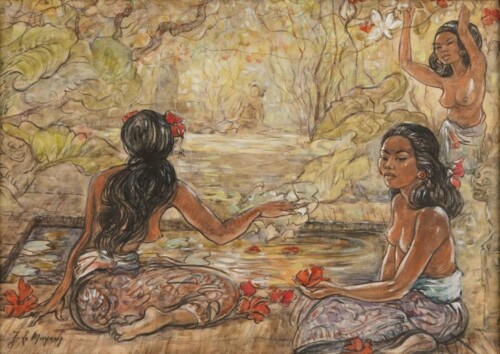
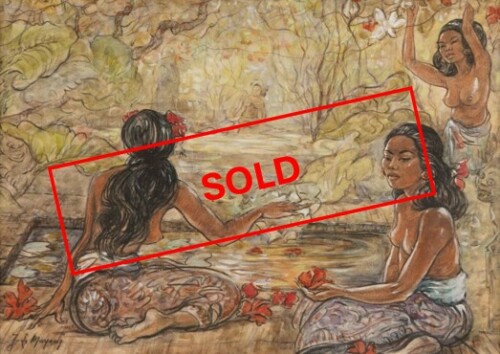
The work is typical of Le Mayeur de Merpres, a Belgian painter, who represented many scenes of everyday life in Bali in the 30s-40s, married to an Indonesian woman Ni Pollok. Le Mayeur came to Bali at Singaraja in 1932. He then stayed in Denpasar and was fascinated by what remained then of Balinese culture, including the people's traditional way of life, the temple rituals and local dances. He was also impressed by the light, color and beauty of the surroundings in the then still quite unspoilt island.- Mixed technique on paper.
- Circa 1940s.
- Signed at lower left.
-
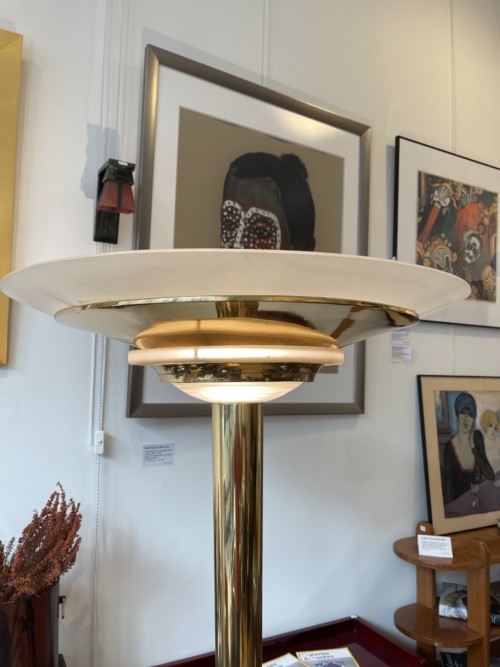
 Jean Perzel (1892-1986) Lampadaire, modèle 41 E GM Lampadaire à coupe éclairante en verre dépoli et laiton doré Signé sur la base Années 30 Ce modèle fut choisi pour décorer l'appartement grand luxe "Trouville" du paquebot Normandie en 1935 ainsi que la galerie des pas perdus à la Société des Nations à Genève (ancêtre de l'ONU) La ville de Paris l'a acheté pour l'exposition internationale des Arts et Techniques de 1937 Dimensions : H : 172 cm ; P : 45 cm Pour plus d’informations sur le créateur, cliquer sur le nom : Jean Perzel
Jean Perzel (1892-1986) Lampadaire, modèle 41 E GM Lampadaire à coupe éclairante en verre dépoli et laiton doré Signé sur la base Années 30 Ce modèle fut choisi pour décorer l'appartement grand luxe "Trouville" du paquebot Normandie en 1935 ainsi que la galerie des pas perdus à la Société des Nations à Genève (ancêtre de l'ONU) La ville de Paris l'a acheté pour l'exposition internationale des Arts et Techniques de 1937 Dimensions : H : 172 cm ; P : 45 cm Pour plus d’informations sur le créateur, cliquer sur le nom : Jean Perzel
Street lamp by Jean Perzel (1892-1986) Floor lamp, model 41 E GM Made of glid brass and frosted glass Signed under the based 1930s Dimensions : H : 67.72 in ; D : 17.72 in H : 172 cm ; D : 45 cm For more information : Jean Perzel